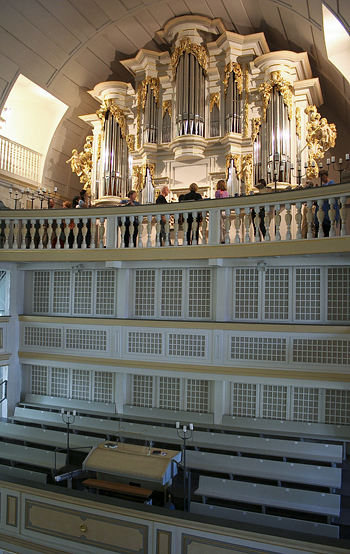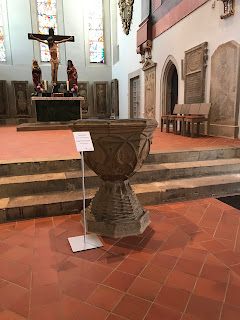Thursday June 14
Bad Sulza to Bad Kösen to Naumberg to Weißenfels
 |
Bike route from Bad Sulza to Weißenfels |
 |
| Bad Kösen graduation works |
 |
| Biking toward Naumburg...1 |
While the entire trip was memorable, the next stop is right near the top of the list! Still following the Saale River, we biked for another 9 kilometers to the town of Naumberg, one of those pretty little medieval towns for which Germany is so famous. Its claims to fame are brief visits by Martin Luther (he stayed, preached, drank and taught here twice), and the fact that it was, for several years, the residence of Friedrich Nietzsch.
 |
| Hildebrandt Organ in Naumberg |
 |
| Keyboards and Stops - some of the stops are original |
But what made it so special for me was our visit to the Wenzelkirche, where, in 1748, Bach was invited to test a new organ built by his colleague Zacharias Hildebrandt. "On the 27th of August 1743, the Naumburg City Council entered into a contract with Zacharias Hildebrandt of Leipzig for the building of the new organ of 52 stops in the existing case of the organ by Zacharias Thayssner (built 1696 -1705). Previously a report from J. S. Bach about the organ had been obtained which was "most kindly found acceptable". Thus we can surely assume that Bach had an influential role in the drawing up of the specification, and that this instrument corresponded to his idea of a fine large organ." This is the final organ report attributed to Bach.
It is still in use today and we were treated to an amazing organ concert and then Anna-Luise, one of the founders of the tour and one our of leaders, appeared next to the organ and began singing "Bereite dich Zion" from Bach's Christmas Oratorio (click here for video).
After a refreshing lunch in the square outside the church we bicycled along the Saale through beautiful countryside to Weißenfels.
 |
| Lunch in Naumburg |
 |
| One of many beautiful vistas along the ride to Weißenfels |
Upon arrival in Weißenfels we checked into our hotel, the Jägerhof (more about this later), and then made our way to the Heinrich Schütz museum. He was Bach's German musical predecessor (1585-1672). I had low expectations about this exhibit but the 2-plus hours I spent there were incredibly informative and entertaining. I left with a very "up close and personal look" at the daily life of a composer/musician from his childhood through to his old age. Click here for a link to the Museum.
We returned to our hotel, the Jägerhof, where, on Feb. 23, 1713, Bach first performed his Hunt Cantata, BVW 208 "Sheep May Safely Graze" - his first known composition making use of horns as well as the modern Italian operatic forms of recitative and da capo aria. Click here for a YouTube recording. Once again, it was thrilling to sip a glass of wine in the very room where this historic event occurred.


















